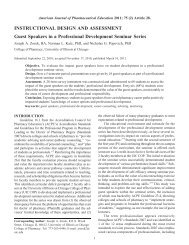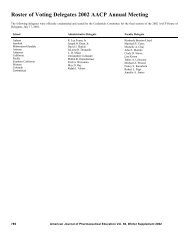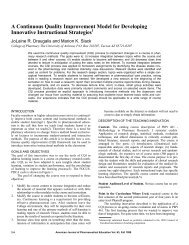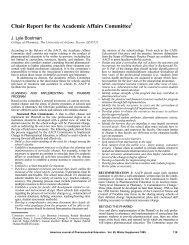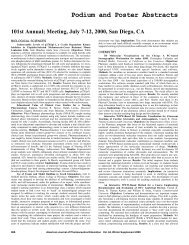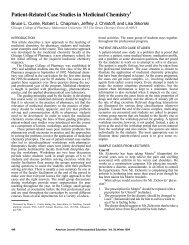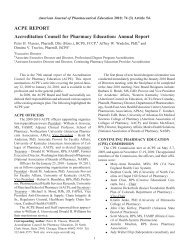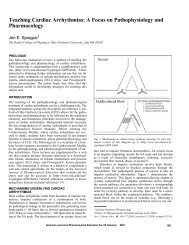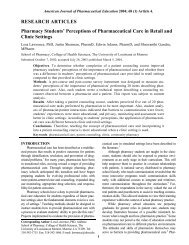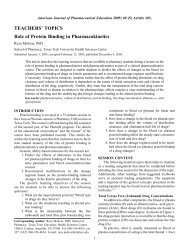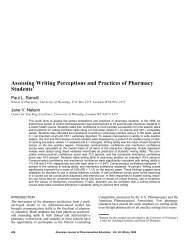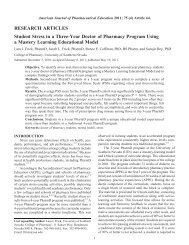RESEARCH ARTICLES Pharmacy Students' Attitudes Toward a ...
RESEARCH ARTICLES Pharmacy Students' Attitudes Toward a ...
RESEARCH ARTICLES Pharmacy Students' Attitudes Toward a ...
You also want an ePaper? Increase the reach of your titles
YUMPU automatically turns print PDFs into web optimized ePapers that Google loves.
American Journal of Pharmaceutical Education 2009; 73 (7) Article 134.<br />
<strong>RESEARCH</strong> <strong>ARTICLES</strong><br />
<strong>Pharmacy</strong> Students’ <strong>Attitudes</strong> <strong>Toward</strong> a Required Public Health Course<br />
and Developing a Public Health Program<br />
Bupendra Shah, PhD, MS, BSPharm, Hamid Rahim, PhD, Hongjun Yin, PhD,<br />
and Jinali Bhavsar, BSPharm<br />
Arnold and Marie Schwartz College of <strong>Pharmacy</strong><br />
Submitted February 26, 2009; accepted April 23, 2009; published November 12, 2009.<br />
Objective. To determine pharmacy students’ attitudes towards a required public health course and<br />
developing a public health program.<br />
Method. Two hundred ten first-year pharmacy students enrolled in a public health course at a large<br />
private pharmacy school were surveyed. A 24-item adjective rating scale and a 10-item scale were used<br />
to measure students’ attitudes towards the course and developing a public health program.<br />
Results. Of 198 respondents, two-thirds found the course to be extremely or very appealing, of<br />
practical value, and only slightly demanding and difficult. The majority of the students indicated that<br />
establishing a public health program would be an opportunity to help the community and make<br />
a difference. Few students indicated that it would be a poor use of time or an example of busy work.<br />
Conclusion. <strong>Pharmacy</strong> students had positive attitudes towards a required public health course and<br />
developing a public health program. Strategies to mold positive attitudes into actual behaviors of<br />
engaging in public health activities are needed.<br />
Keywords: public health, attitudes, pharmacy curriculum<br />
INTRODUCTION<br />
With the increasing threat of epidemics such as swine<br />
flu (H1N1), and widespread chronic illnesses, such as<br />
those arising from obesity, the need for effective and efficient<br />
public health programs is apparent and urgent.<br />
Several reports on the challenges and future of public<br />
health have identified appropriate training and education<br />
for the public health workforce as a top priority along with<br />
the need for interdisciplinary participation in public<br />
health. 1 A prepared quality workforce is of paramount<br />
importance if the complex public health issues of the<br />
21 st century are to be addressed. Accordingly, educational<br />
academies and institutions engaged in training medical,<br />
nursing, pharmacy, and allied healthcare professionals<br />
are creating training programs and modifying their curriculums<br />
to improve professional competencies in assessing<br />
and monitoring public health problems and include<br />
disease prevention and health promotion activities.<br />
Historically, pharmacy was considered the least active<br />
healthcare profession in terms of contributing toward<br />
public health service. Three decades ago, in a seminal<br />
Corresponding Author: Bupendra Shah, BSPharm, MS,<br />
PhD, Assistant Professor, Social and Administrative Sciences<br />
Division, Arnold and Marie Schwartz College of <strong>Pharmacy</strong>,<br />
Long Island University, B12, 75 Dekalb Avenue,<br />
Brooklyn, NY 11201. Tel: 718-780-4593.<br />
E-mail: bupendra.shah@liu.edu<br />
1<br />
article, authors Bush and Johnson noted that ‘‘not nearly<br />
enough pharmacists are now engaged in public health<br />
activities,’’ and that ‘‘pharmacy education has failed to<br />
recognize the potential for pharmacists in public health.’’ 2<br />
The authors argued that while micro-level pharmacists<br />
(pharmacists who provide service at the individual patient<br />
level) were important for providing patient-specific interventions,<br />
macro-level pharmacists (pharmacists who focus<br />
on the health status of the community as a whole and<br />
play an active role in assessment, policy development,<br />
planning, and evaluation of needed services) were<br />
equally, if not more, fundamental to the establishment<br />
of effective pharmacist-provided public health activities.<br />
The authors emphasized the need to graduate pharmacists<br />
with abilities to participate in both macro- and microlevel<br />
public health service. Since their paper was published,<br />
the pharmacy profession has expended several<br />
efforts to develop competent pharmacists with capabilities<br />
to engage in public health-related services, such as<br />
smoking cessation, disease management, and prevention,<br />
such as immunizations. 3 Despite these efforts, few pharmacists<br />
have been directly involved in disease prevention<br />
and health promotion activities in the past decade. The<br />
majority of pharmacists are still focused on providing<br />
medication-related services. Common reasons for lack<br />
of pharmacist involvement in public health activities include<br />
lack of training and constraints, such as a heavy
American Journal of Pharmaceutical Education 2009; 73 (7) Article 134.<br />
workload. 4 Also, many of the public health activities are<br />
considered as secondary activities that are provided only<br />
when resources (people, time, and money) allow since<br />
they do not produce revenue.<br />
Given their relatively recent recognition as providers<br />
of preventative services, 5-7 pharmacists, like other healthcare<br />
professionals, will now be expected to play an active<br />
role in the public health arena. Accordingly, training<br />
pharmacists as public health providers will need to become<br />
a central part of their curriculum. Traditionally,<br />
little course work was devoted to public health. To address<br />
this gap and develop student competencies in the<br />
area of public health prevention services and health promotion,<br />
the American Association of College of <strong>Pharmacy</strong><br />
(AACP) released the Social and Administrative<br />
Sciences (SAS) Supplemental Educational Outcomes in<br />
2007. 8 These outcomes recognize the need for pharmacists<br />
to provide public health programs that take into account<br />
risk factors and pharmacoepidemiologic data and<br />
challenge practitioners to ‘‘assure that all relevant members<br />
of a patient population receive needed services.’’<br />
Concepts related to public health have been integrated<br />
into the curriculum of some pharmacy colleges. 9 Such<br />
a curriculum should provide pharmacy students with the<br />
competencies required to integrate public health principles<br />
in their practice after graduation.<br />
A central question while integrating public healthrelated<br />
concepts in the curriculum is whether public<br />
health concepts should be incorporated into an existing<br />
course, taught as an independent required course, or offered<br />
as an elective course. Much of the literature on<br />
public health in pharmacy has focused on students’ attitudes<br />
toward and experiences in service-learning projects<br />
in a course that was offered either as an elective or<br />
a pharmacy practice experience. While pharmacy students<br />
have responded positively toward elective and experiential<br />
public health courses, their perceptions<br />
regarding a required public health course have not been<br />
reported/studied previously.<br />
In order to successfully develop a curriculum that<br />
meets the goals outlined in the SAS Outcomes, the attitudes<br />
and values of pharmacy students regarding public<br />
health must be assessed. While there is abundant literature<br />
on nursing students’ and medical students’ attitudes towards<br />
public health and health promotion, 10-13 the literature<br />
on pharmacy students’ attitudes towards public<br />
health is sparse. This study assessed pharmacy students’<br />
attitudes towards a required public health course, as well<br />
as their attitudes towards developing a public health program.<br />
The findings provide insight into student enthusiasm,<br />
in general, towards learning public health-related<br />
principles as an integral part of the curriculum.<br />
2<br />
The main objective of this study was to explore pharmacy<br />
students’ attitudes toward a required public health<br />
course and assess their attitudes toward developing a public<br />
health program. A secondary objective was to test the<br />
psychometric properties of the scales used in the study.<br />
METHODS<br />
Public Health in <strong>Pharmacy</strong> is a required first-year<br />
course in the doctor of pharmacy (PharmD) program at<br />
the Arnold and Marie Schwartz College of <strong>Pharmacy</strong> The<br />
course was developed in 2006 by faculty members in the<br />
Social Administrative Sciences and <strong>Pharmacy</strong> Practice<br />
divisions at the college using public health-related concepts<br />
outlined in Clinical Prevention and Population<br />
Health Framework for Health Professions, a publication<br />
developed by the Healthy People Curriculum Task<br />
Force 14 and based on the endpoints outlined in the AACP<br />
Supplemental outcomes for SAS. 8 The course was consequently<br />
approved by the curriculum committee at the college<br />
in 2006. The content areas covered in the lecture<br />
portion of the course (3 hours each week) consisted of:<br />
(1) introduction to public health: what is public health,<br />
history of public health and pharmacist role in public<br />
health, definitions widely used in public health, healthy<br />
people 2010 goals; (2) evidence-based practice: epidemiology<br />
and biostatistics, methods for evaluating health research<br />
literature, outcome measures, determinants of<br />
health, and health surveillance; (3) health promotion: program<br />
development principles using the precede-proceed<br />
model with an emphasis on cultural competence and eliminating<br />
health disparities; (4) health systems and health<br />
policy: organization and financing of public health activities;<br />
and (5) community aspects of practice: pharmacist<br />
role in emergency preparedness such as bioterrorism, immunizations,<br />
chronic disease management and prevention<br />
services, environmental and occupational health,<br />
and international health issues.<br />
During the recitation portion of the course (1 hour<br />
each week), students were assigned an ethnicity (non-<br />
Hispanic whites, African-Americans, Asians, and<br />
Hispanics) on which they worked individually and collaboratively<br />
in groups to (1) design a health promotion<br />
and disease prevention program, and (2) present and explain<br />
the program to the recitation section and faculty<br />
members. Students were provided with a series of community<br />
needs assessments forms designed by the authors<br />
based on the precede-proceed model, 15 which was taught<br />
in an earlier course (Behavior and Ethics in <strong>Pharmacy</strong>),<br />
and emphasized as an important model for developing<br />
public health programs. The needs assessment form was<br />
completed by each student as a homework assignment and<br />
used by each group to identify and explore the health
American Journal of Pharmaceutical Education 2009; 73 (7) Article 134.<br />
problems for the assigned ethnicity. Each group was required<br />
to write and submit a report identifying health<br />
problems that their group would target using health promotion<br />
and disease prevention principles. Upon identifying<br />
the target health program for intervention, students<br />
were asked to explore the different evidence-based public<br />
health programs published in the literature and identify<br />
the goals, methods, and evaluation plan utilized by those<br />
programs. A week after this exercise, groups were asked<br />
to develop goals, methods, and evaluation plans for their<br />
own programs. Students were challenged by the faculty<br />
member to be as realistic as possible in developing the<br />
program. In the final 3 weeks of the semester, each group<br />
presented the whole program (including the needs assessment,<br />
goals, methods, and evaluation plan) to the recitation<br />
class and submitted a final report that outlined the<br />
different components of the program in detail. Approximately<br />
40% of the course grade was based on program<br />
development and presentation.<br />
On the first day of the semester, students were provided<br />
with a syllabus and recitation manual and details<br />
about the course and were asked to complete a WebCT<br />
(Blackboard, Washington DC) survey during the first<br />
week, for which they would receive 1 point extra credit<br />
towards their final grade. Following recommendations<br />
from the university’s institutional review board, students<br />
were asked to provide consent for faculty members to use<br />
their survey data for research purposes. Students were<br />
assured they would receive the extra credit regardless of<br />
their decision to provide consent to use the data.<br />
Measures<br />
Two main measures were used in the survey: the 24-<br />
item adjective rating scale and the 10-item Carter and<br />
Cochran measure of attitudes towards service-learning. 16<br />
Five questions also queried students about their demographic<br />
information. The adjective rating scale utilizes<br />
24 adjectives, such as interesting, boring, and difficult,<br />
to categorize students’ attitudes towards a course into 1<br />
of 3 factors: affective appeal and practical value; apathy;<br />
or difficulty. The adjectives in the affective appeal and<br />
practical value factor describe positive feeling towards<br />
the course and its practical value, whereas the adjectives<br />
in the apathy factor describe negative feeling and interest<br />
towards the course. The adjectives described in the difficulty<br />
factor capture the extent to which students find the<br />
course difficult and demanding. Students used a 4-point<br />
Likert-type scale ranging from extremely to not at all to<br />
gauge the adjective in each of the factors. Although the<br />
adjective rating scale had not been utilized in pharmacy<br />
prior to this study, it was selected because it had been<br />
validated using healthcare professionals (nurses) whose<br />
3<br />
functions in the context of public health would be very<br />
similar to pharmacists and because it had good construct<br />
validity. A 10-item measure designed by Carter and<br />
Cochran to assess student perspectives on service-learning<br />
projects in a public health course was adapted to assess<br />
student attitudes towards public health program development.<br />
16 Little was known about the psychometric properties<br />
of the Carter and Cochran measure, however, it was selected<br />
because it met the criteria for face and content validity.<br />
Data obtained from the survey were de-identified and<br />
exported into SPSS, version 14.5. Although its construct<br />
validity already had been established by prior research,<br />
the reliability of the adjective rating scale was computed<br />
using Cronbach’s alpha. Construct validity of the Carter<br />
and Cochran measure was conducted using a principalcomponents<br />
analysis with Varimax rotation using Eigenvalues<br />
over 1 as criteria for factor extraction. Descriptive<br />
and univariate analyses were conducted and presented.<br />
RESULTS<br />
One hundred ninety eight (response rate 94%) of the<br />
210 students enrolled in the course provided consent to<br />
use their responses for research purposes. Two-thirds of<br />
the respondents were female. The majority of the respondents<br />
were single, had completed high school prior to<br />
entering pharmacy school, were less than 25 years old,<br />
came from diverse economic backgrounds, and identified<br />
their race as either non-Hispanic white or Asian (Table 1).<br />
The reliability of the adjective rating scale was computed<br />
using Cronbach’s alpha. The standardized alpha<br />
for the 24-item adjective rating scale was 0.72, indicating<br />
a moderate but acceptable degree of internal consistency.<br />
17 Construct validity of the adapted Carter and<br />
Cochran measure was computed using principal components<br />
analysis, with Varimax rotation using Eigen values<br />
over 1 as criteria for factor extraction. In the analysis,<br />
student responses identified a single factor. The loadings<br />
(the correlations of each of the items in the scale with the<br />
factor), indicated that the majority of items in the scale<br />
had a moderate to high correlation (range from 0.60 to<br />
0.81) with the factor (Table 2). The proportion of variance<br />
accounted by the items in the scale was 54.8%. In the<br />
reliability analysis using Cronbach’s alpha, the standardized<br />
alpha for the 10-item scale of students’ attitude toward<br />
a public health program was 0.84, indicating a high<br />
degree of internal consistency. 17<br />
On the 24-item adjective rating scale, 2 out of 3 students<br />
chose ‘‘extremely’’ or ‘‘very’’ scale anchors for the<br />
different adjectives in the affective appeal and practical<br />
value factor (eg, interesting, relevant, good, stimulating)<br />
of the adjective rating scale, indicating that the majority of<br />
students had positive feelings towards the course and
American Journal of Pharmaceutical Education 2009; 73 (7) Article 134.<br />
thought the course had practical value (Table 3). Only<br />
one-third of students selected ‘‘extremely’’ or ‘‘very’’<br />
scale anchors for the different adjectives in the apathy<br />
factor of the adjective rating scale, affirming the finding<br />
that few students had negative feelings towards the<br />
course. Approximately, two-thirds of the students chose<br />
the ‘‘slightly’’ scale anchor for the 2 adjectives (demanding<br />
and difficulty) in the difficulty factor of the adjective<br />
rating scale, indicating that students felt that the course<br />
was only slightly demanding and difficult.<br />
Students’ attitudes towards development of a public<br />
health program were positive. More than 80% agreed or<br />
strongly agreed that the program would be an opportunity<br />
to help the community, promote the practice of pharmacy,<br />
apply their knowledge, and make a difference. Few students<br />
indicated that it would be a poor use of time and an<br />
example of busy work, or be a bad experience of working<br />
in groups. Approximately 1 in 4 students disagreed that<br />
the public health program would be an overwhelming responsibility<br />
(Table 4). None of the demographic variables<br />
such as age, gender, marital status, average annual household<br />
income, and level of education achieved were associated<br />
with summative scores on students’ attitudes<br />
toward the development of a public health program.<br />
4<br />
DISCUSSION<br />
As the most accessible and trusted healthcare professionals,<br />
pharmacists are in an ideal position to play an<br />
important role in public health promotion and disease<br />
prevention activities. 18 From a pharmacy education perspective,<br />
the findings of this study that pharmacy students<br />
were positive towards a required public health course and<br />
developing a public health program are encouraging. The<br />
majority of the students indicated that the program would<br />
be an opportunity to help the community, promote the<br />
practice of pharmacy, apply their knowledge, and make<br />
a difference in society. Despite that the program development<br />
aspect of the course demanded that students complete<br />
a number of difficult and time-consuming tasks,<br />
only 1 in 4 students found the course to be difficult and<br />
demanding. Students appeared to be able to quickly adopt<br />
and apply the course skills and achieve efficacy. Their<br />
attitude may have been ‘‘This is not difficult to do.’’<br />
The lack of apathy toward the course among students<br />
could be attributed to the departure of this course from<br />
the highly clinical pharmacotherapy courses in the curriculum.<br />
Alternatively, it also could have been a reflection<br />
of the positive energy displayed by the faculty members in<br />
the course. Although not measured, faculty members who
American Journal of Pharmaceutical Education 2009; 73 (7) Article 134.<br />
taught the course displayed enthusiasm, positive energy,<br />
and commitment to public health activities, which may<br />
have influenced student assessment of the course. Given<br />
the similar results of earlier studies focusing on students’<br />
opinions of elective and experiential courses, pharmacy<br />
students seem to see a lot of value in taking public healthrelated<br />
courses. It could also be due to the high expectations<br />
or perceptions first-year pharmacy students may<br />
have about pharmacists’ roles in the health care system.<br />
Finally, it could also be a function of the rating scale used<br />
to measure pharmacy student attitudes in this study.<br />
From an academic pharmacy perspective there are<br />
several implications from the findings of the study. <strong>Pharmacy</strong><br />
student enthusiasm about public health education is<br />
high. This provides an opportunity to not only make public<br />
health education a part of pharmacy education but also<br />
make curricular changes and interventions required to develop<br />
pharmacy student competencies and facilitate them<br />
in becoming public health care providers. Because this is<br />
the only public health course offered in their pharmacy<br />
education, students’ positive attitudes for a public health<br />
course should be maintained and support given throughout<br />
their education so that they can implement health promotions<br />
programs in their future professional practice.<br />
This could be done through several mechanisms including<br />
collaborations between schools offering public health<br />
5<br />
degrees and pharmacy schools, pharmacy schools and departments<br />
of public health, and student participation in research<br />
activities identified by the PharmD gateway to the<br />
National Institute of Health. 19 Finally, it is essential to create<br />
an environment where students realize that the burden<br />
of working together and creating common public health<br />
goals rests on the shoulders of all healthcare professionals.<br />
So far, the medical and nursing professions have taken an<br />
active lead in developing health promotion and disease<br />
management programs. This study shows that future pharmacists<br />
will be more receptive to active participation in<br />
health promotion and disease management programs.<br />
However, more work needs to be done to create public<br />
health program teams that include physicians, nurses, pharmacists,<br />
and allied healthcare professionals. Again, collaborations<br />
between medical, nursing, and pharmacy schools<br />
can serve as a forum through which pharmacy students can<br />
become an integral part of a public health care team.<br />
Since the course is relatively new, the pedagogic exercise<br />
that required developing but not implementing<br />
a public health program was designed to get students to<br />
think about the issue and their future role as pharmacists<br />
in health promotion and disease prevention. While this<br />
was the first step, teaching students how to implement<br />
their public health programs will be vital to them realizing<br />
the impact they could have on the development and
American Journal of Pharmaceutical Education 2009; 73 (7) Article 134.<br />
implementation of public health programs in the future.<br />
To that end, plans are being made to modify the course to<br />
allow for implementation of the programs developed by<br />
students. Currently, faculty members are exploring the<br />
possibility for developing a service-learning component<br />
for the course. The service-learning component would<br />
enable pharmacy students to develop and implement<br />
community-based health education and disease prevention<br />
programs in nursing homes, homeless shelters, and<br />
schools, and measure the outcomes from the programs.<br />
Given the large number of students (over 200) enrolled in<br />
the course, the task of assigning students to different sites<br />
will be challenging. Nonetheless, the potential benefit to<br />
pharmacy students, people in the targeted communities,<br />
and society overall will be tremendous and a step toward<br />
fulfilling the mission of pharmacy in public health.<br />
Several limitations are associated with this study.<br />
First, this study was conducted in a single school of pharmacy<br />
at a private university that caters to a diverse ethnic<br />
group of students in a large metropolitan city. Thus, generalization<br />
of study findings is limited. Second, the course<br />
described in the study was developed using the public<br />
6<br />
health-related concepts outlined in the Clinical Prevention<br />
and Population Health Framework for Health Professions<br />
developed by the Healthy People Curriculum<br />
Task Force 14 and based on the endpoints outlined in the<br />
AACP Supplemental outcomes for SAS. 8 Courses not<br />
based on these concepts may yield differential responses.<br />
Third, social desirability bias induced by the survey<br />
methods may be partially responsible for the overall positivity<br />
displayed in student responses. A non-personal forum<br />
(WebCT by Blackboard, Washington DC) was used<br />
to reduce this bias. Fourth, the data collected for the study<br />
was only quantitative in nature. Qualitative data would<br />
have provided more insights into areas of the course that<br />
could be improved. Finally, this is the first study to use the<br />
adjective rating scale in pharmacy. While it has been<br />
validated in nursing studies, future studies need to examine<br />
the validity of the adjective rating scale for assessing<br />
pharmacy students’ attitudes.<br />
CONCLUSION<br />
<strong>Pharmacy</strong> students have a positive attitude towards<br />
public health-related concepts being taught in a required
American Journal of Pharmaceutical Education 2009; 73 (7) Article 134.<br />
public health course, and towards developing public<br />
health programs. Curricular changes and collaborations<br />
with public health departments, schools, and other healthcare<br />
professional programs need to be made to mold these<br />
positive attitudes into actions as pharmacy students become<br />
future public health providers.<br />
REFERENCES<br />
1. Institute of Medicine. The Future of the Public’s Health in the 21 st<br />
Century. Washington, DC: National Academies Press; 2002.<br />
2. Bush PJ, Johnson KW. Where is the public health pharmacist? Am<br />
J Pharm Educ. 1979;43(3):249-52.<br />
3. Smith RE, Kerr RA, Nahata MC, Roche VF, Wells BG, Maine LL.<br />
Engaging communities: academic pharmacy addressing unmet public<br />
health needs. Report of the 2004-05 Argus Commission. Am J Pharm<br />
Educ. 2005;69:S22.<br />
4. Kotecki JE, Elanjian SI, Torabi MR. Health promotion beliefs and<br />
practices among pharmacists. J Am Pharm Assoc. 2000;40(6):773-9.<br />
5. Grabenstein JD. Pharmacists as vaccine advocates: roles in<br />
community pharmacies, nursing homes, and hospitals. Vaccine.<br />
1998;16(18):1705-10.<br />
6. Law AV, Okamoto MP, Chang PS. Prevalence and types of<br />
disease management programs in community pharmacies<br />
in California. J Managed Care Pharm. 2005;11(6):505-12.<br />
7. Doucette WR, McDonough RP, Klepser D, McCarthy R.<br />
Comprehensive medication therapy management: identifying and<br />
resolving drug-related issues in a community pharmacy. Clin Ther.<br />
2005;27(7):1104-11.<br />
8. American Association of Colleges of <strong>Pharmacy</strong>. Social and<br />
Administrative Sciences Supplemental Educational Outcomes Based<br />
on CAPE 2004. Available at: http://www.aacp.org/resources/<br />
education/Pages/CAPEEducationalOutcomes.aspx Accessed June<br />
23, 2009.<br />
9. Lenz T, Monaghan M, Hetterman E. Health Promotion and<br />
Wellness Topics in <strong>Pharmacy</strong> Education. Paper presented at the<br />
Annual meeting of the American Association of Colleges of<br />
<strong>Pharmacy</strong>, Sheraton San Diego Hotel and Marina, San Diego,<br />
California. Available at: http://www.allacademic.com/meta/<br />
p118151_index.html Accessed June 23, 2009.<br />
10. Gorin SS. Student nurse opinions about the importance of health<br />
promotion practices. J Community Health. 1992;17(6):367-75.<br />
11. Bellas PA, Asch SM, Wilkes M. What students bring to<br />
medical school: attitudes toward health promotion and<br />
prevention. Am J Prev Med. 2000;18(3):242-8.<br />
12. Horowitz MM, Byrd JC, Gruchow JW. <strong>Attitudes</strong> of faculty<br />
members, residents, students, and community physicians toward<br />
health promotion. J Med Educ. 1987;62:931-7.<br />
13. Meakin RP, Llyod MH. Disease prevention and health<br />
promotion: a study of medical students and teachers. J Med Educ.<br />
1996;30(2):97-104.<br />
14. Allan J. Clinical prevention and population health: curriculum<br />
framework for health professions. Am J Prev Med. 2004;27(5):471-6.<br />
15. Green LW, Kreuter MW. Health Program Planning: An<br />
Educational and Ecological Approach. 4th edition. NY:<br />
McGraw-Hill Higher Education; 2005.<br />
16. Carter JT, Cochran GA. Service-learning projects in a public<br />
health in pharmacy course. Am J Pharm Educ. 2002;66(3):313-8.<br />
17. Thorndike RM. Measurement and Evaluation in Psychology and<br />
Education. 6th Ed. Upper Saddle River, NJ: Prentice Hall; 1996.<br />
18. Babb VJ, Babb J. Pharmacist involvement in Healthy People<br />
2010. J Am Pharm Assoc. 2003;43:56-60.<br />
19. National Institute of General Medical Sciences. Pharm.D.<br />
Gateway to NIH. Available at: http://www.nigms.nih.gov/Training/<br />
PharmD/. Accessed October 20, 2009.<br />
7



